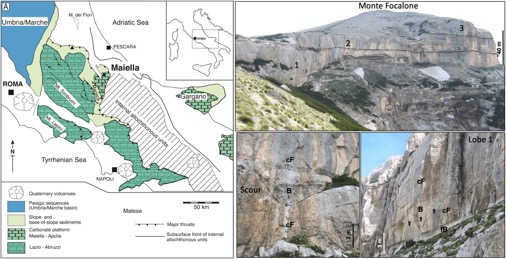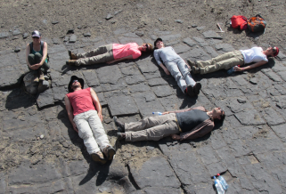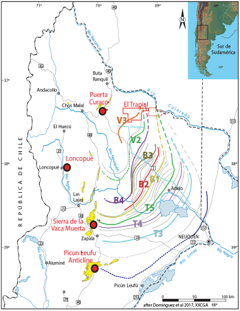|
Drift Delta Maiella Mountains

2023 TBA or upon request
Goal: To illustrate the geometry and facies distribution in a carbonate drift delta with discussions on sedimentary processes
Rationale: The recognition of the coarse-grained bioclastic wedge of the Orfento Formation as a drift delta prompts the re-examination of sea-level controlled deposition in carbonates. Current control is likely more important than previously thought.
Related Files:
Maiella_F...tion.pdf Description
Outcrop Evaluation for Subsurface Correlation of The Vaca Muerta Formation, Neuquén Basin
 
2023 TBA or upon request
Rationale: The Vaca Muerta Formation in the Neuquén Basin has proven its unconventional resource potential. Taking advantage of the excellent exposure of the formation the CSL has assembled an outcrop data set that can be exploited as analog to the subsurface in the Neuquén Basin. Data include synthetic seismic sections and laboratory petrophysical measurements for a robust outcrop-seismic correlation and a understanfding of seismic and elastic properties of Vaca Muerta mixed siliciclastic-limestone mud rocks.
The aim is to use an accurate, high-resolution outcrop – subsurface correlation to highlight how geologic sections collected in outcrop can enhance the understanding of seismic-derived acoustic impedance in the foresets and bottom sets of the Vaca Muerta. In addition, our composite sections in the Puerta Curaco area provide a formidable framework for a comprehensive assessment of the distribution of the facies and total organic carbon (TOC) of the entire Vaca Muerta Formation. This correlation of outcrop sections to core and well-logs is achieved by measuring spectral gamma ray, TOC and other geochemical properties with high resolution (0.5-1m spacing) in each outcrop section.
Goal: The main aim of this field trip in the Neuquén Basin is to demonstrate how the detailed outcrop analysis can be a guide for interpreting subsurface data and potentially help solving questions for well placement and production.
Objectives:
- Illustrate the facies of Vaca Muerta – Quintuco system along a proximal to distal transect and the lateral distribution and vertical variability of TOC in the basin.
- Relate the facies and geometries to the seismic facies and correlate changes in lithology and the diagenesis to chemical and petrophysical signatures measured with logging tools.
- Discuss the outcrop-subsurface correlation based on calibration of outcrop geometry and lithology logs to subsurface logs and synthetic seismic sections.
Location: The seminar begins and ends at the airport in Neuquén, Argentina. Field stops at different outcrops in the south of the basin (Picun Leufú and Sierra de la Vaca Muerta) illustrate facies distribution and sequence stratigraphic architecture of the Vaca Muerta System in the southern clinoforms. Well-exposed outcrops in the Puerta Curaco (PC) area further north contain the complete section of the organic-rich basinal facies. Across the three different outcrop locations, you will observe the facies in the prograding clinoforms from the topset (shelf), to the foreset, and finally a basinal bottomset. The Sierra de la Vaca Muerta area offers great insight into the progradational style of the Vaca Muerta-Quintuco system especially the time transgressive nature of the different facies. The transect will document that the high TOC is not restricted to a unique stratigraphic level but is a recurring pattern within the prograding depositional system, resulting in multiple organic-rich zones in similar sequence stratigraphic positions in each sequence. In addition, we will demonstrate the subtle variability of organic and carbonate content in different types of siliceous to more cemented mudstones. The outcrops also provide a 2-D view away from the section that is equivalent to having lateral view around a well.
Itinerary:
Day 1: Neuquén - Zapala plus introduction
Day 2: Picun Leufu and Sierra dela Vaca Muerta, base of Vaca Muerta
Day 3: Sierra de la Vaca Muerta, proximal clinoforms (drive to Chos Malal)
Day 4: Basinal sections at the Puerta Curaco area
Day 5: Aguada de los Tamariscos section and return to Neuquén
Who should attend: Exploration and production geoscientists and reservoir engineers working in the Vaca Muerta or in unconventional mixed system reservoirs around the world.
Costs: ~$5,500 (USD), Includes all ground transportation, lodging, meals, course notes, and relevant presentations and posters in digital form.
Important Note: A minimum of 8 attendees will be required for this trip.
Related Files:
2023_Fiel...erta.pdf Description
Facies Successions on Great Bahama Bank - Implications for Exploration and Reservoir Characterization

2023 TBA or upon request
Core, seismic workshop and 6 days field seminar.
Leaders: Gregor P. Eberli and Paul M. (Mitch) Harris
Location: Begins and ends in Miami, Florida. The first day we fly to Bimini, to board the chartered Research Vessel Coral Reef II that will provide our lodging and food as we cross Great Bahama Bank for a series of key field stops. We will fly from Nassau to Miami on the last day.
Objectives:
1. Illustrate the depositional processes and dimensions of facies belts on an isolated platform.
2. Improve the interpretation of subsurface data of carbonate systems.
3. Relate filling of accommodation space and facies heterogeneities to reservoir models.T
Who Should Attend: Petroleum geologists, geophysicists and reservoir engineers who are working in carbonates and need to understand facies heterogeneities and porosity distribution at exploration and production scales.
Content: This seminar explores the vertical and lateral facies successions and resultant heterogeneities of Great Bahama Bank.
The seismic and core workshop on day 1 illustrates the architecture of the prograding western margin of Great Bahama Bank. Cores across the platform margin provide a unique opportunity to examine the sequence stratigraphic distribution of facies and diagenetic modification in platform carbonate reservoirs. Log and laboratory data from these cores provide insights into porosity/velocity relationships and permeability distribution in platform carbonates.
Days 2 – 6 are spent in the Bahamas. The facies belts on Great Bahama Bank display the depositional variation that may occur in ancient hydrocarbon reservoirs. We explore this spatial heterogeneity on several scales, on the large carbonate platform scale but also within each facies belt such as ooid shoals and reef. Simultaneously we explore the fundamental controlling processes and the sedimentary structures that record these processes. Together, the sedimentary structures, dimensions and lateral variability of classic reservoir facies are examined during the seminar. Field stops include the leeward platform margin (Cat Cay Ooid Shoal), the platform interior, the tidal flats of Andros, the ooid shoals of Joulters Cay, patch reefs, and the Andros Island barrier reef. Pleistocene outcrops on Bahamian islands graphically show how these facies are preserved in the ancient rock record.
Cost: ~$7,500 - Transportation to and from the Bahamas, all ground transportation, on-board boat accommodation in the Bahamas, meals, and course notes are included.
Contacts: Gregor P. Eberli (305) 421 4678 [email protected]
Related Files:
2023_Baha...inar.pdf Description
Ooid Sands and Microbialites Along the Exumas Margin - Depositional Models, Stratigraphic Framework and Reservoirs

2023 TBA or upon request
Location: The 6-day seminar begins and ends in Nassau on New Providence Island, Bahamas. Several field stops along the island chain of the Exumas are visited by boat along the carbonate platform margin that is dominated by ooid grainstone facies and the largest occurrence of modern normal marine stromatolites.
Objectives:
- Examine exploration-scale facies belts of variable ooid and microbial deposits along a windward margin.
- Illustrate the dynamic evolution of grainstone facies during the Holocene transgression that imparts reservoir-scale heterogeneity.
- Relate a complex stratigraphic record of sea-level oscillations to subsurface correlation.
Who should attend: Exploration and production geoscientists and reservoir engineers working in grainstone and microbial carbonate reservoirs and those exploring along platform margins.
Seminar Content: The seminar will illustrate the relationships and dimensions in an ooid-dominated, high-energy platform margin as well as the relationship of stromatolites and associated facies. We will show the dynamic development of these grainstone bodies and associated stromatolites during the Holocene sea-level rise and illustrate the heterogeneity in Pleistocene strata from both the depositional and diagenetic perspective created by sea-level oscillations within the last interglacial highstand (MIS 5e).
Costs: $6,400.-, Includes all ground transportation, lodging on boat, meals, and course notes with virtual field seminar in digital form.
Related Files:
2023_Exum...lyer.pdf
Complex Stratigraphy of a windward platform margin – New Providence and Eleuthera Islands, Bahamas

2023 TBA or upon request
Leaders: Gregor P. Eberli, Peter K. Swart, and Paul M. (Mitch) Harris
Seminar Content: The six-day seminar examines the complex stratigraphy and diagenesis in platform margin grainstone successions around New Providence and Eleuthera Islands on the most windward margin of Great Bahama Bank.
The modern ooid shoals of the Schooner Cays are a very large tidal bar belt whose size and heterogeneity is largely driven by currents and their interaction with platform margin morphology. Sea-level fluctuations produce stacks of grainstone complexes along platform margins. On New Providence and Eleuthera Islands, two vertically stacked shallowing-upward sequences of oolitic coastal deposits are exposed. Pleistocene sea-level fluctuations repeatedly exposed the platform top, forming numerous karst features. The size and dimensions of sinkholes, flank margin and horizontal caves are illustrated during the seminar. We visit a hypersaline lake where microbial processes lead to the formation of carbonates.
Itinerary:
Field seminar starts and ends in Nassau, Bahamas. The seminar can be tailored in length and focus but generally consists of the following program:
Day 1: New Providence Island: The sedimentary record of the last interglacial MIS 5e at Clifton Pier and Serenity Outcrop
Day 2: Modern Coral Reefs offshore New Providence Island.
Day 3: Stacked Pleistocene grainstones along the windward margin of Eleuthera at Pine Outcrops, North Twin Coves, The Cliffs, Hatchet Bay Caves and Glass Window.
Day 4: Modern ooid tidal bar belt are Schooners Cays: Facies and Geometries.
Day 5: Platform Facies and Karst Features on Eleuthera
Day 6: Return to Nassau
Costs: ~$5500.- per person: The costs include accommodation, food, transportation in the Bahamas, guidebook, and snorkeling equipment.
Related Files:
2023_Eleu...lyer.pdf Description
|









